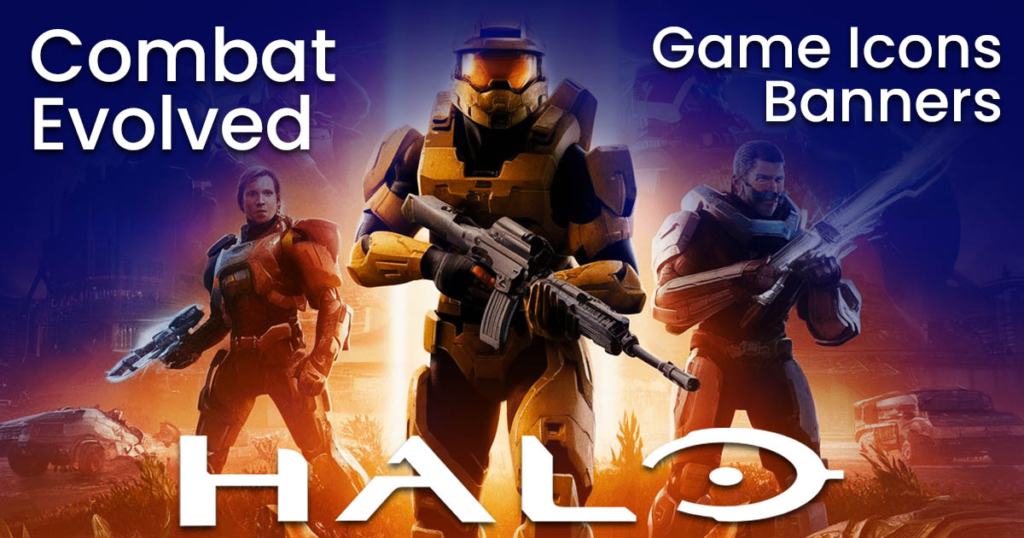
halo (2003) game icons banners
The Legacy of Halo: Combat Evolved
halo (2003) game icons banners Before we dive into the specific icons and banners, it’s essential to understand the context and significance of Halo: Combat Evolved itself. Released in 2001, and maintaining prominence in 2003, Halo wasn’t just a game; it was a revolution in first-person shooters, setting a benchmark for all future games in the genre.
halo (2003) game icons banners The game, developed by Bungie and published by Microsoft Game Studios, was a launch title for the Xbox, which gave the console an enormous boost. It was a massive commercial success, with millions of copies sold and an ardent fanbase built around the title. But what made Halo truly unique was its world-building, its memorable characters, and, of course, its captivating visual identity.
Why Icons and Banners Matter in Gaming

When discussing a game’s success, people often talk about gameplay mechanics, storytelling, and graphics. Yet, the role of the game’s branding elements—such as icons and banners—shouldn’t be underestimated. These visual elements serve as the face of the game, instantly recognizable to fans and newcomers alike. For Halo, these visual elements were vital in creating the immersive experience and contributing to its long-term brand loyalty.
The importance of visual branding goes beyond mere aesthetics. For many players, it’s a symbol of their experience, a shorthand for the hours spent immersed in a different world. Halo’s icons and banners aren’t just images; they’re symbols that have been ingrained in gaming history.
Iconography in Halo: The Most Recognizable Symbols

The visual iconography of Halo: Combat Evolved is packed with symbols that carry immense weight. Whether it’s the logo of the UNSC, the Covenant’s alien insignias, or the mysterious Halo ring itself, each icon tells its own story and conveys its unique identity.
Master Chief’s Visor: The Face of Halo
Master Chief’s helmet is arguably one of the most iconic images in gaming. halo (2003) game icons banners With its green reflective visor, the helmet represents strength, mystery, and survival. From the moment the game starts, players are introduced to this character, and the helmet is central to his identity.
In the game’s early marketing materials, Master Chief’s helmet was always halo (2003) game icons banners prominently featured. Bungie knew this character, clad in his MJOLNIR armor, would become an instantly recognizable figure. While we never see his face, the visor becomes his defining feature. Every gamer who sees it knows they’re looking at one of the most legendary characters in gaming history.
The Halo Ring: A Symbol of Infinite Possibility
Perhaps the second most iconic image from Halo is the titular Halo ring itself. halo (2003) game icons banners The structure is a massive, ring-shaped artificial world that players explore throughout the game. The ring has become synonymous with the game’s mysterious and awe-inspiring atmosphere.
When you think of the name “Halo,” your mind immediately goes to the image halo (2003) game icons banners of the ring floating in space, reflecting a shimmering planet beneath it. It’s a powerful visual that perfectly encapsulates the game’s blend of science fiction and mysticism. Its circular form also hints at the idea of cycles, both in the game’s narrative and gameplay design.
UNSC and Covenant Insignias: Factions Defined by Logos
The battle between the United Nations Space Command (UNSC) and the alien halo (2003) game icons banners Covenant forces is central to Halo’s story. Both factions have their own distinct logos and iconography that help define their identity within the game’s universe.
The UNSC’s logo, featuring an eagle with wings spread wide, symbolizes humanity’s military might and resilience. The sleek, angular design of the Covenant insignias, meanwhile, reflects their advanced alien technology and their religious zeal. These faction icons are not only used in the game but are also prominently displayed in marketing materials, helping players quickly identify the sides in this epic conflict.
Cortana’s Holographic Figure: The Digital Icon
No discussion of Halo icons would be complete without mentioning halo (2003) game icons banners Cortana, the AI companion who plays a pivotal role in the game. Visually represented by a holographic figure, Cortana’s ethereal, translucent form became a defining image for the game.
Her design, with glowing blue circuitry running through her body, evokes the idea of advanced technology and artificial intelligence. She stands out as an iconic image, even among the other visual elements in Halo. As a character, Cortana adds emotional depth to the game, but as an icon, her image is instantly recognizable and synonymous with Halo’s futuristic world.
The Role of Banners in Halo’s Marketing and In-Game Experience
Banners, both physical and digital, have played a crucial role in the halo (2003) game icons banners Halo series’ marketing efforts. Whether promoting the game itself or used in-game to signify different factions or events, banners have been a significant part of the visual storytelling in the Halo universe.
Early Marketing Banners: Setting the Tone for the Game
Back in 2003, game marketing was taking giant strides toward the future. halo (2003) game icons banners Banners for Halo: Combat Evolved were plastered across websites, gaming stores, and conventions. These promotional materials often featured the Master Chief in full armor, standing against a backdrop of either space or an alien world. The use of stark contrasts in color—green for Master Chief’s armor, blue for the planet, black for the vastness of space—created an immediate sense of tension and adventure.
The banners were simple yet effective. They didn’t give too much away but showed just enough to draw players in. The tagline “Combat Evolved” was featured prominently on many of these banners, hinting that this was not just another shooter but something entirely new.
In-Game Banners: Symbolism and Identity
Within the game itself, banners play an essential role in setting the tone halo (2003) game icons banners and conveying the conflict between the factions. Throughout the campaign, players encounter banners adorned with faction symbols, particularly those of the Covenant. These banners are often found hanging in key locations, like enemy strongholds or sacred sites, helping to reinforce the game’s world-building and the religious zeal of the Covenant forces.
The contrast between the cold, militaristic logos of the UNSC and the halo (2003) game icons banners ornate, religiously infused designs of the Covenant banners is striking. This visual distinction helps players quickly identify the different factions and their ideological differences.
Online Multiplayer and Custom Banners
One of the unique aspects of Halo is its multiplayer mode, which allows players to engage in large-scale battles against one another. In multiplayer, banners often serve as markers for different teams or objectives. For example, flags in Capture the Flag games are adorned with team logos, and bases often display team-specific banners.
Additionally, Halo’s multiplayer community became known for its customization options. Players could choose from a wide range of emblems, many of which were inspired by in-game banners and icons, to represent their team or clan. These emblems became personal banners that players could carry into battle, a small but important part of the player’s identity within the Halo universe.
Evolution of Halo Icons and Banners Over the Years
Since its debut in 2003, Halo has evolved, and so too have its icons and halo (2003) game icons banners banners. With each new installment, the design language of the game has shifted, incorporating new visual elements while staying true to the core identity established in the original game.
Halo 2 and 3: Refining the Iconography
With the release of Halo 2 in 2004 and Halo 3 in 2007, Bungie began to refine halo (2003) game icons banners the iconography of the series. The Master Chief’s armor became sleeker, the Halo rings more detailed, and the faction logos more prominent. The design of the Covenant’s symbols also evolved, reflecting the expanding lore of the series and the growing importance of the Covenant’s religious hierarchy.
One of the most iconic images from Halo 3 is the Master Chief standing tall on a battlefield, his visor reflecting the fiery destruction around him. This image was used extensively in banners and promotional materials and became a defining symbol for the game.
The Rise of Forge Mode: Custom Banners Take Center Stage
With the introduction of Forge mode in Halo 3, players were given halo (2003) game icons banners unprecedented control over the game’s maps and design elements. This mode allowed players to create their own custom levels, complete with banners and logos of their choosing. This creative freedom led to an explosion of custom content, with players designing their own banners to represent their maps, teams, and even fictional factions within the Halo universe.
Forge mode was a game-changer in many ways, and it allowed players to take ownership of the visual elements that had defined the series. It wasn’t just Bungie creating the banners anymore; it was the community itself, expanding on the visual language of the game in exciting and unexpected ways.
Conclusion: Icons and Banners That Stand the Test of Time
The icons and banners of Halo are more than just visual elements; they’re part of the fabric that holds the Halo universe together. Whether it’s the imposing figure of Master Chief, the mysterious Halo rings, or the battle banners of the Covenant and UNSC, these images have become symbols of gaming excellence.
Over the years, Halo has continued to evolve, but its visual identity remains halo (2003) game icons banners one of the most recognizable in the gaming world. The power of its icons and banners lies in their ability to convey so much with so little—whether it’s the heroism of Master Chief, the enigma of the Halo rings, or the unyielding might of the UNSC. These images have become more than just game assets; they’re part of gaming history.





